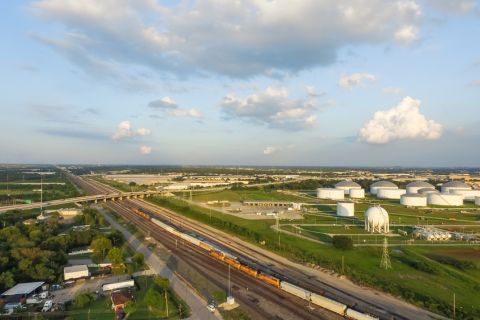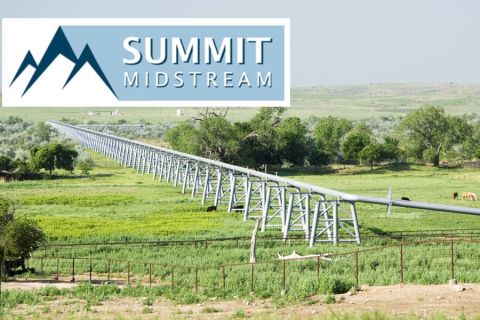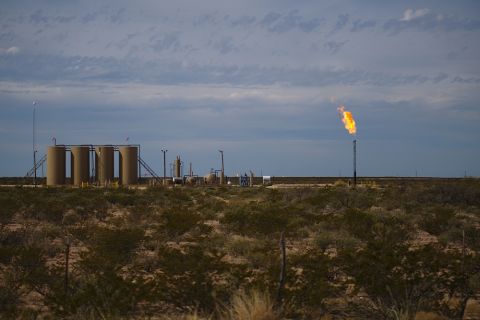It's "the hottest play in the U.S.," EOG Resources Inc. chairman and chief executive Mark Papa says of the Eagle Ford. The designation is not without validation within the EOG portfolio: The producer is in virtually all of the hot plays. In the South Texas shale, its wells are making average first production of between 700 and 1,600 barrels (bbl.) of oil per day—plus gas and natural gas liquids.
The Eagle Ford's oil, wet-gas and dry-gas output have captured not only the attention of domestic E&Ps' capex programs but that of internationals ranging from China's CNOOC Ltd. to Australia's BHP Billiton Ltd.
And, midstream operators are hot to get the light crude oil and wet gas, in particular, to market. It's turned the Gulf Coast energy corridor on its head. In quarterly reports this summer, the whopping play was acknowledged by dozens of E&Ps, oilfield-service companies, pipeline operators and refiners—as well as companies ranging from electric-power infrastructure firm Quanta Services Inc. to rail operator Union Pacific Corp.
Top wells reported from Eagle Ford to date include privately held Enduring Resources LLC's #1 Keach Gas Unit in DeWitt County, making 1,010 bbl. of condensate and 15.8 million cubic feet (MMcf) of gas its first day, and a Karnes County blockbuster, Pioneer Natural Resources Co.'s #1 Handy, that came in at some 20 MMcf.
A prolific gas-liquids-maker, ConocoPhillips' #2 Butler A-304 in La Salle County came in at 1,348 bbl., plus 7.5 MMcf of dry gas.
Where does it all go? For many producers, not all of it is going to sales yet. Curtailments are regular in South Texas these days as the burgeoning supply is overwhelming take-away. All means are being deployed—from truck to rail to barge to pipe. Many wells in resource plays across the U.S. are waiting on completion—or WOC—as supply of hydraulic-fracturing crews is tight. In the Eagle Ford, producers are working on that they don't just merely move these wells from the WOC column to a "waiting on pipeline" column.
Keeping up on the take-away side remains hard to do, as new wells continue to top output of early wells. For example, at Swift Energy Co., which has a legacy position in South Texas and is making gas- and liquids-rich output from both the Eagle Ford and Olmos formations, seven recent wells had combined initial production (IP) rates of 41 MMcf of high-Btu gas, 1,600 bbl. of natural gas liquids (NGLs) and 2,400 bbl. of oil. Its SMR EF 3H averaged 1,230 bbl. of oil. Its R Bracken 38H IP'ed 578 barrels of NGLs. And, its Bracken JV 8H IP'ed 10.9 MMcf of gas.
But, a second-quarter gas-production curtailment put its growth from the first quarter at -1%. Terry Swift, chairman and chief executive, notes the company made arrangements earlier this year for additional take-away capacity on a new 25-mile gas pipeline that Southcross Energy LLC expects to bring online in this quarter. "This new pipeline will effectively meet all of our processing and transportation needs in McMullen County," he says.
And, he adds, it's a reflection of Eagle Ford wells' success—that the "pipeline-capacity issues along the trend are just one more indication that the productivity of the wells in the Eagle Ford shale is greater than and improving faster than anyone had expected."
Take-away under way
Shippers are already planning further expansions as output continues to grow. On their combined multibillion dollars worth of punch lists are new processing, pipe and fractionation of natural gas, NGLs, crude oil and condensate—entirely to Gulf Coast end-users, refiners and petrochemical plants.
At Energy Transfer Equity LP, some $1.15 billion of Eagle Ford infrastructure has been announced in the past 12 months alone. To handle natural gas, its Dos Hermanas and Chisholm lines are already in service, taking a combined 500 MMcf per day, and another 200 MMcf of daily capacity on Chisholm is planned by third-quarter 2013. Now, "we have turned our attention to addressing the high demand for NGL transportation and processing that we're seeing in the marketplace…," says Martin Salinas, Energy Transfer chief financial officer.
Crosstex Energy LP is also eyeing NGLs. It is working, via its Cajun Sibon project, to capture South Texas gas liquids—as well as NGLs from the Permian Basin, Midcontinent, Barnett shale and Rockies—at interconnects near fractionators at Mont Belvieu, Texas, and take them away to its Eunice, Louisiana, fractionation plant.
Barry Davis, Crosstex president and chief executive, says the Eunice facility's output will supply South Louisiana petrochemical plants, which are accessing decreasing NGL supply as Gulf of Mexico production continues to decline. The pipe expansion will take it to 70,000 bbl. of NGLs per day and fractionation capacity at the Eunice plant will go to 55,000 bbl. per day.
Crosstex already has an agreement to sell ethane to The Williams Cos. Inc.'s olefins subsidiary, which produces 1.3 billion pounds of ethylene and 90 million pounds of polymer-grade propylene at its Geismar, Louisiana, plant on the Mississippi River. "So we're very confident in our ability to get this to final commercial commitments and feel really good about the project," Davis says.
At Mont Belvieu, Enterprise Products Partners LP, which has 350 miles of pipe under way out of Eagle Ford, is working on expanding fractionation capacity as well. Brad Olsen, midstream research analyst for Tudor, Pickering, Holt & Co. Securities Inc., says Enterprise dominates the gas-, NGL- and oil-shipping business in the South Texas play.
Its pervasiveness in the region is so much that, for investors, he says, it "can get E&P customers the best netbacks by handling every link between wellhead and petrochemical NGL demand centers." It can put "more than two times more organic capex to work than any other midstream company through 2012 at the earliest."
At Mont Belvieu, Enterprise announced this summer it will add a sixth NGL fractionator there, increasing capacity by 75,000 bbl. per day, taking the plant to more than 450,000 bbl. per day. Just last year, Enterprise had only three trains at work at Mont Belvieu. A fourth came online earlier this year, and a fifth is to be completed by year-end, capturing South Texas barrels that are currently going to Louisiana for fractionation.
Enterprise is betting on estimates that more than 900 wells are currently producing 850 MMcf of gas and 140,000 bbl. of oil and condensate per day from the Eagle Ford play, which was discovered just three years ago and didn't begin to receive significant drilling attention until just 18 months ago.
And, as of this summer, another 1,400 Eagle Ford wells were being drilled or were WOC, Enterprise estimates, so the output will soon grow.

Ethane supply from NGLs produced from the Eagle Ford and other plays across the U.S. is projected to grow 44% by 2014. Demand may grow faster but exceed supply by 2017.
* Aug. 23, 2011. ** To be determined. Notes: Analysis assumes ethane comprises 45% of new NGL fractionation capacity and an operating rate of 90%. Source: Wells Fargo Securities LLC estimates from company reports, EIA and Hodson Report data.
NGL users
End-users' appetite for the NGLs is whet as petrochemical-plant operators are favoring the less expensive NGLs over crude-oil derivatives as feedstock, says Jim Teague, Enterprise executive vice president and COO.
"Petrochemical facilities have responded (to new NGL supply) with announcements of planned new construction or modifications to make greater use of NGL feedstocks. In the last 12 months alone, about 100,000 to 150,000 bbl. per day of heavy (crude) cracker feedstocks have been replaced with light-end (NGL) feedstocks," he says.
Michael Blum, Wells Fargo Securities LLC senior research analyst covering MLPs , reports in the August edition of his monthly "NGL Snapshot" that he continues to expect strong demand for ethane—one of the derivatives of NGLs—as more crackers are put online by resellers and users. "Notably, the ethane-to-crude-oil ratio has increased to more than 36% currently from about 30% at the beginning of the year, further reinforcing our positive near-term outlook for ethane prices."
Over-supply may be seen in 2013 to 2015 as more fractionation capacity comes online at Mont Belvieu and elsewhere, he adds. For example, in 2014, daily ethane production capacity will reach 1.284 million bbl. and demand will be restricted at 1.097 million bbl.
"However, assuming two of the announced new-build ethylene plants (by The Dow Chemical Co., Chevron Phillips Chemical and LyondellBasell) will be constructed in 2016 to 2017, we forecast that the ethane market could return to balance in 2016 and become undersupplied in 2017," Blum says.
Among midstream operators in a position to build upon the growing NGL supply are 21 publicly traded MLPs, he notes. Among these, 18 are involved in processing and 13 do this as well as own NGL fractionation, pipeline and storage assets with the heaviest weights being Enterprise and Oneok Partners LP.
Eagle Ford oil
An end-user anxious to get Eagle Ford oil into its system is Valero Energy Corp., which operates six refineries along the Gulf Coast. The shale-play oil is making Valero's bottom line look good. First, it's light oil and more easily refined; second, it's cheaper than using seaborne shipments that are priced on Brent, which is some $15 to $25 more costly per barrel than West Texas Intermediate—or Cushing-priced—crude.
During the second quarter, Valero took an average of 37,000 bbl. per day of Eagle Ford oil, up nearly 50% from the 25,000 bbl. it took daily in the first quarter. "This crude replaced expensive waterborne, sweet crudes, saving around $16 per barrel in the second quarter," says Mike Ciskowski, Valero executive vice president and chief financial officer.
And, it wants more. "We are continuing to look for additional ways to use more of this discounted crude," he says.
In this quarter, Valero plans to process 25,000 bbl. per day of Eagle Ford crude at its Corpus Christi, Texas, refinery; its Three Rivers, Texas, refinery will be able to process nearly 60,000 bbl. per day of Eagle Ford oil by year-end.
When more makes it way to Corpus, it could process a total of 100,000 barrels of Eagle Ford oil per day there, including through one of two units that predominantly handles medium to heavy, sour crude.
Lane Riggs, Valero senior vice president, refining operations, says, "At the end of the day, it's all about economics. We can run Eagle Ford in that (heavy) crude unit. It's just a matter of the oil being available and the economics are right."
The company is also looking at expanding its McKee refinery in the Texas Panhandle, where Midcontinent oil plays are posting growing output. Bill Klesse, chairman, chief executive and president, says of that and the South Texas plant plans, "Those are projects that we would not have considered two years ago—would not have considered one year ago."

“Notably, the ethane-to-crude-oil ratio has increased to more than 36% currently from about 30% at the beginning of the year, further reinforcing our positive near-term outlook for ethane prices.” – Michael Blum, senior analyst, Wells Fargo Securities LLC
Harvest Pipeline Co. is building a 50-mile extension from Eagle Ford to serve Valero's Three Rivers plant where capacity is 95,000 bbl. per day. Riggs says, "Harvest Pipeline will be there. And we've put in a big truck rack. We will not be logistically limited on Eagle Ford availed in the refinery. It will all be about the economics of the Eagle Ford, which, today, we would run as much of it as we could."
Also near the source of South Texas liquid gold, NuStar Energy LP plans to use Eagle Ford crude and condensate at a 14,500-barrel-a-day, seven-truck-bay refinery on the south side of San Antonio that it bought earlier this year from AGE Refining Inc.'s Chapter 11 bankruptcy portfolio. It includes a 200-barrel-a-day terminal at nearby Elmendorf, Texas.
"The refinery's proximity to the Eagle Ford Shale is a big plus," says Curt Anastasio, NuStar president and chief executive. "The light crude oil that is coming out of the Eagle Ford shale is well-suited…and it is in our backyard, so our transportation costs are low…We're able to take advantage of these lower-cost South Texas sweet crudes and realize transportation-cost savings, which will enhance the refinery's profitability."
More destinations
In its transportation segment, NuStar has reactivated an idled, 60-mile line, Pettus South, from Pettus, Texas, to Corpus Christi that ties into an expanded Koch Pipeline Co. LP line in South Texas and is delivering 30,000 bbl. of crude oil a day.
Koch has added 25,000 bbl. of daily oil and condensate capacity and, with Arrowhead Pipeline LP, it is adding another 50,000 bbl.s of take-away from the western Eagle Ford window. Koch is also expanding deliverability to the Flint Hills Resources LP waterborne terminal at Ingleside, Texas, near Corpus. Another 60-mile line from Pettus to Corpus will take Koch's deliverability to 250,000 bbl. per day from the Karnes County area by next summer.
Flint Hills' update of its Ingleside terminal will have the capacity to ship 200,000 bbl. per day via barge to Gulf Coast refiners and users. Altogether, increased capacity into Corpus and Ingleside via Koch will take it to more than 350,000 bbl. per day.
To refiners and petrochemical companies at the Houston Ship Channel, Kinder Morgan Energy Partners LP is building a new 300,000-barrel-a-day oil and condensate line from the Eagle Ford that will open this spring. Petrohawk Energy Corp., which was acquired at press time by BHP Billiton, has committed 50,000 bbl. a day and just that much will make a return on KMEP's investment, says Rich Kinder, chairman and chief executive, although "we certainly expect to fill the great bulk of the 300,000 bbl. a day over some time period."
Kinder Morgan picked the Houston Ship Channel as the oil's destination because there is a preponderance of refiners there, thus more odds of the supply being used. Also, it has a large tank battery at the ship channel to hold excess barrels.
"I think that, in the long run, there is going to be just a hell of a lot of condensate coming out of the Eagle Ford," Kinder says. "It's going to seek the highest, best use. Some will end up in refineries in Houston, some in Corpus. Some will go over to Baton Rouge and into other pipelines there. Some, I think, will end up being used as diluents. There are just all kinds of different uses."
Shipper and user competition for the condensate is strong, he notes. "And there will be a lot of good services offered to people who are producing condensate in Eagle Ford. And that should be the case."

Capacity for shipping NGLs, crude oil and condensate to markets is quickly growing out of the Eagle Ford play.
Source: FBR Capital Markets Research
Pushing Cushing back
Plains All American Pipeline LP president and chief operating officer Harry Pefanis says the Eagle Ford has the greatest logistical issues among areas in which it plans to complete projects in 2012, including expansions at Patoka, Illinois, and out of the Permian Basin as well as a reversal of its Wascana system that will take Bakken oil into Saskatchewan.
"There's a lot drilling going on in the Eagle Ford, a lot of rigs running, and very little pipeline infrastructure. So right now, trucks are moving the vast majority of the excess volumes that came from pipes," Pefanis says. "There are also some rail facilities that are being placed in service."
Plains is building a new 130-mile oil and condensate line out of Eagle Ford, a marine terminal and 1.5 million bbl. of storage.
Greg Armstrong, Plains chairman and chief executive, says, "There's really an absence of a main infrastructure there to move crude oil out, but there's a lot being built. I think there have been five projects announced."
New production from South Texas going to Gulf Coast users is contributing to a backup of oil supply at Cushing where WTI is priced. There, 55,000 to 60,000 more barrels of crude are going in than going out per day. Some oil production from the Bakken oil play in North Dakota is being rerouted directly to the Gulf Coast, including by rail, where the price competes with more expensive seaborne shipments.
"It's taken some of that pressure off Cushing, but, at the same time, there's more crude production coming from West Texas and the logical home for that is Cushing. So it's probably fair to say that, for the next 12 to 18 months in general, there's going to be pockets of these imbalances," Armstrong says.
"There will be shorter-terms solutions and then, inevitably, there may be some take-away overkill that goes on with respect to some of the longer-term solutions. So we end up with too much pipe coming out of these new plays.
"But it's hard to forecast that at this point because you don't know which of the many projects that have been announced are actually going to get done." He notes that Eagle Ford and Bakken oil is light. Potential new oil supply from the Utica shale play in Ohio is light too. "And so you're talking about probably an aggregate—no matter whose story you believe—of at least over 1 million bbl. a day of new, very light product. It's going to change the dynamics in an industry that's been gearing up for heavy or sour product."
Producers in waiting
At Chesapeake Energy Corp., its own midstream subsidiary, Chesapeake Midstream Partners LP, is building out "big pipe" take-away infrastructure. Meanwhile the company is building 150 oil trucks to get the oil out from there and elsewhere.
"Across the board, there's a shortage of oil-hauling trucks, a shortage of drivers, a shortage of pipeline. But, through our midstream entity and through our relationships with other midstream companies, we're out there meeting those logistical challenges," says Aubrey McClendon, Chesapeake chairman and chief executive.
While lining up the parts, the company had to move expectations for an additional 2 million bbl. of new 2011 liquids production to its 2012 sales forecast instead. "We had hoped that would not be possible but decided now is the time to recognize those constraints, that we're going to work through them and work through them a lot with solutions that are homemade," McClendon says.
Murphy Oil Corp., which is selling its refining business to focus on E&P, including in South Texas, and on its retail-fuel business, is making 7,200 barrels of oil equivalent (BOE) a day from Eagle Ford currently. "We've got full wells that are producers that we don't have on (pipe). So unconstrained, I think we could produce more," says David Wood, Murphy president and chief executive.

“Across the board, there's a shortage of oil-hauling trucks, a shortage of drivers, a shortage of pipeline. But, through our midstream entity and through our relationships with other midstream companies, we're out there meeting those logistical challenges.” — Aubrey McClendon, chairman and chief executive, Chesapeake Energy Corp.
"We have a number of field batteries being developed. We have a number of pipelines. This is not an 'all flow into one place' sort of development. So I think the off-take capacity is going to have to be improved through this year and into next year for us and for a number of other players to start removing some of the bottlenecks.
"We have some growing pains." But commitments are being made for new off-take arrangements and pipelines. "So I think all this will be worked out, certainly into next year," Wood says.
Even ConocoPhillips, which is also de-integrating to focus on E&P, has met with take-away hurdles in South Texas, where it is making 24,000 BOE per day, 75% liquids, and expects to be running 16 rigs by year-end, up from 13 earlier this year. Jeff Sheets, chief financial officer and senior vice president, finance, says, "Well results there remain encouraging, but we do have some production curtailments due to third-party condensates-trucking constraints. We probably could be producing a little over 30,000 bbl. a day if we had no production constraints out there.
"So we'll have periods where we're going to catch up, and then we'll have periods where we will fall behind again. But I would think, as we move into 2012 and 2013, we would expect to be out of the curtailment situation."
At Pioneer Natural Resources, infrastructure build continues. It has completed installation of six central gas-processing facilities; a seventh will be completed in this quarter and an eighth by year-end. "So we are really ahead of the game when it comes to build-out of infrastructure," says Tim Dove, Pioneer president and chief operating officer.
As for its oil, that's being trucked. "Since we were one of the early guys in there and, in doing so, were working on infrastructure before anyone else, we have all the trucks in hand that we need to move oil. So it's really not an issue."
The company is working on barging; for now, it's getting $4 to $5 off WTI for its condensate. Scott Sheffield, Pioneer chairman and chief executive, says major agreements are in place with DCP Midstream LLC, Enterprise and Copano LLC. "Everybody is cooperating. We're able to execute on getting our product to market," Sheffield says.
The size of the prize
Rehan Rashid, managing director and group head, energy and natural resources research, for FRB Capital Markets, estimates the Eagle Ford play is worth at least $85 billion to producers and as much as $200 billion as best practices in tapping the formation improve.
Take-away capacity will be tight near-term in the Eagle Ford, but solutions are coming, he says.
"Our analysis of existing basin pipeline take-away capacity indicates tightness through the end of first-quarter 2012." By 2013, he expects an additional 1.4 million bbl. of daily condensate and crude oil take-away capacity and 0.9 billion cubic feet of daily natural gas take-away.

“Everybody is cooperating. We're able to execute on getting our product to market.” — Scott Sheffield, chairman and chief executive, Pioneer Natural Resources Co.
Meanwhile, trucking, rail and barging will be essential and some production might have to be held back. Yet, even this doesn't seem to keep the play down. Because seaborne crude oil is more costly to Gulf Coast refiners—that is the Brent versus WTI or domestic crude-oil price—the additional cost of getting oil to market due to the lack of sufficient pipeline infrastructure is not a bottom-line-buster.
"Producers are realizing something very close to WTI," he says. Trucking to big pipe or to the end user costs some $2.50 per barrel and most production is heading to Corpus Christi on the Texas coast. Barging it to other refiners along the Gulf Coast costs an additional $2 a barrel. "Pipelines will take it to the Gulf Coast and, hence, should be able to capture a bigger portion of the WTI/Brent premium," he says.
How much more work is there to do? Rashid's $85-billion estimate for the Eagle Ford's worth is the base case and it's likely to change to his $200 billion estimate, which is the high case, in time. The low-case number is based on current first-30-day production rates and estimated ultimate recovery per well; the high case, on if improvement in tapping the resources is similar to advancements shown in the Barnett and Fayetteville plays as producers have worked those over the years.
"Our analysis indicates that every doubling of cumulative wells drilled in other shale plays has yielded a 15% to 23% improvement in productivity as measured by increases in the average 30-day production rate," he says.
In the Barnett, each time the number of wells drilled has doubled in the past, the average first-30-day IP has improved 17.5%, he says. In the Fayetteville, 23.1% each time; the Bakken, 15.6%; and the Haynesville, 15%.
At the current pace of drilling the Eagle Ford, with 140 rigs at work, he forecasts the well count will double every 12 to 15 months. He then compares the outlook for the Eagle Ford to what has been demonstrated in the Bakken, which is also oil-rich and the flow of oil is more complicated than that of gas, which is a smaller molecule.
"Assuming that the Eagle Ford learning curve follows the same 15.6% path as the Bakken and taking into account the current and forecasted rig count, we would expect the 30-day average IP rates in the oil window to increase to 850 BOE per day by the fourth quarter of 2012 and to 1,100 by the end of 2015," he says. This would be improved from the average 585 BOE per day that was posted at year-end 2010.

Energy producers and midstream operators meet every year in San Antonio, Texas, home of the Alamo and Hart Energy’s annual Developing Unconventional Gas-Eagle Ford conference, to discuss new developments in the prolific Eagle Ford unconventional oil and gas play.
In the Eagle Ford, EOG Resources holds 561,000 net acres in the oil and wet-gas fairways, the No. 1 position in these. Its output—net, after royalty—this summer hit 34,000 BOE per day, 83% crude oil. "I expect we'll consistently be the largest Eagle Ford net oil producer for the next decade," Papa says.
Getting it to market has been without interruption, as it's had transportation contracts in place beginning earlier this year. "As you've undoubtedly heard on multiple earnings calls this summer, everything in the Eagle Ford is tight: rigs, frac equipment and crews, sand and product take-away capacity. So far, we've dodged a lot of bullets and haven't had to slow our 2011 program down because of bottlenecks."
There should be plenty for shippers to take away in the coming decades. Papa says EOG's own 535,000 net acres in the Eagle Ford oil window holds about 21 billion BOE in place, net after royalty.
If 4% of the total is recovered on 130-acre spacing, "our current stated net-after-royalty oil-recovery potential is 900 million BOE, which we believe is the largest, Lower 48 onshore domestic net oil discovery in the last 40 years.
"Now that we've got the reservoir characterized, we're working on ways to improve this recovery factor."
Recommended Reading
Midstream Operators See Strong NGL Performance in Q4
2024-02-20 - Export demand drives a record fourth quarter as companies including Enterprise Products Partners, MPLX and Williams look to expand in the NGL market.
Summit Midstream Launches Double E Pipeline Open Season
2024-04-02 - The Double E pipeline is set to deliver gas to the Waha Hub before the Matterhorn Express pipeline provides sorely needed takeaway capacity, an analyst said.
Enbridge Announces $500MM Investment in Gulf Coast Facilities
2024-03-06 - Enbridge’s 2024 budget will go primarily towards crude export and storage, advancing plans that see continued growth in power generated by natural gas.
Waha NatGas Prices Go Negative
2024-03-14 - An Enterprise Partners executive said conditions make for a strong LNG export market at an industry lunch on March 14.
Targa Expects Another Major Permian Pipeline Project This Year
2024-05-03 - Targa Resources says different projects are falling in place for gas capacity expansion





